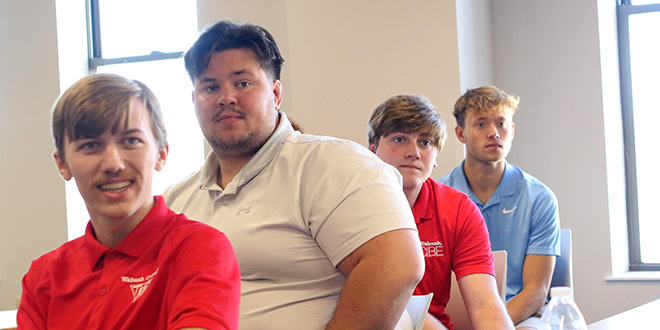The 15 students in Professor Shamila Gelbman’s PSC 211 class, “Election Polling and Public Opinion,” are strengthening their political literacy by learning about public opinion polls through their history, methodology, and media influence.
Understanding political polls and how to use them is quickly becoming a necessary skill during election season.
“There are more polls than ever before, polls are more complex, and there is wide variation in the extent to which different media outlets cover poll results,” Gelbman, a political science professor, said in a statement. “Polling and media literacy are the most important things students should learn in the current iteration of this course.”
On October 3, students presented information and facilitated discussion with community members at a “Lunch with the League” event at Fusion 54. This was an opportunity to work as an expert at an event hosted by Montgomery County and share ideas with others. League of Women Voters and Community Engagement Alliance.
“It was really fun,” Isaac Morrison ’26 said. “We tend to think that what we learn in the classroom is confined to the classroom. When you embrace that idea and go out and see people nodding and smiling and learning something from you, it really helps. I find it beneficial to apply it to my life and help others in the process.”
The influence of political polls is not lost on these students.
“This class taught me how influential polls can be during an election period,” said Olivier Tuissime ’25, a political science major from Indianapolis. “One simple poll on a particular political topic or candidate can significantly sway the outcome of an election.”
Class discussions discuss the bandwagon effect (polls show that a candidate is likely to win), declining turnout (election results are a foregone conclusion based on reported poll results), We showed how polls can influence voting, such as increasing voter turnout (which appears to be the case) or increasing turnout. (Polls show a close race, and voters feel their vote could make a real difference.)
“Polarization has permeated the public debate about polling and the legitimacy of polling, necessitating a renewed focus on polling and media literacy in this latest iteration,” Gelbman said. . “This was also the motivation for us to apply for a Community Engagement Alliance grant to bring student poll literacy learning to the broader campus and local community.”
Mr. Morrison enjoyed learning about the history of public opinion polls and how they continue to evolve as technology advances. He pointed to the fact that, despite the ubiquity of smartphones, it is now harder to reach people reliably than in the 1950s and 1960s, when landlines were in almost every home. listed.
“You would think voting would be easy because everyone has a cell phone in their pocket,” said the personal protective equipment major from Wylie, Texas. “But it comes with so many challenges.”
Issues such as sampling error, demographics, quality of questions, and polarization are what interest the group and offer a unique perspective to Gelbman, who has taught the class every presidential election year since 2012. be. Each offering is different, but the level of interest is strong.
“I am very pleased with the enthusiasm of our students this year,” she said. “They demonstrated that they understood the material well, asked good questions about it, and were able to share that learning with constituents in their local communities.”
PSC 211 students are scheduled to participate in another “Lunch with the League” on October 31st to discuss exit polls.

